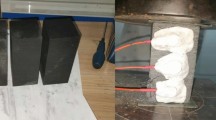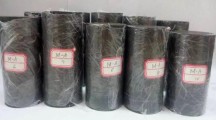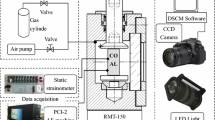Abstract
Theoretical and experimental studies have revealed that energy dissipation and release play an important role in the deformation and failure of coal rocks. To determine the relationship between energy transformation and coal failure, the mechanical behaviors of coal specimens taken from a 600-m deep mine were investigated by conventional triaxial compression tests using five different confining pressures. Each coal specimen was scanned by microfocus computed tomography before and after testing to examine the crack patterns. Sieve analysis was used to measure the post-failure coal fragments, and a fractal model was developed for describing the size distribution of the fragments. Based on the test results, a damage evolution model of the rigidity degeneration of coal before the peak strength was also developed and used to determine the initial damage and critical damage variables. It was found that the peak strength increased with increasing confining pressure, but the critical damage variable was almost invariant. More new cracks were initiated in the coal specimens when there was no confining pressure or the pressure was too high. The parameters of failure energy ratio β and stress drop coefficient α are further proposed to describe the failure mode of coal under different confining pressures. The test results revealed that β was approximately linearly related to the fractal dimension of the coal fragments and that a higher failure energy ratio corresponded to a larger fractal dimension and more severe failure. The stress drop coefficient α decreased approximately exponentially with increasing confining pressure, and could be used to appropriately describe the evolution of the coal failure mode from brittle to ductile with increasing confining pressure. A large β and small α under a high confining pressure were noticed during the tests, which implied that the failure of the coal was a kind of pseudo-ductile failure. Brittle failure occurred when the confining pressure was unloaded—an observation that is important for the safety assessment of deep mines, where a high in situ stress might result in brittle failure of the coal seam, or sudden outburst.
















Similar content being viewed by others
Abbreviations
- A :
-
A constant related to the fractal characteristic of the fragments
- C :
-
Cohesion
- D :
-
Fractal dimension
- E :
-
Elastic (tangential) modulus
- E 0 :
-
Initial elastic modulus without damage
- M R :
-
Mass of fragments of size less than R
- M T :
-
Total mass of fragments
- N :
-
Number of fragments of size greater than R
- R :
-
Characteristic size of fragments
- U d1 :
-
Energy dissipation before peak strength
- U d2 :
-
Energy dissipation during stress drop
- U d3 :
-
Energy dissipation during residual deformation
- U e :
-
Elastic energy
- U ec :
-
Elastic energy at the peak strength
- U ed :
-
Elastic energy at the drop stress
- U f :
-
Failure energy
- W :
-
Work done by axial load
- W c :
-
Total work done by axial load before peak strength
- W d :
-
Total work before the drop stress
- a, k, c, σ 0 :
-
Parameters for fitting the elastic modulus
- b :
-
Mass-size frequency parameter
- α :
-
Stress drop coefficient
- β :
-
Failure energy ratio
- β d1 :
-
Energy dissipation ratio before the peak strength
- β d2 :
-
Energy dissipation ratio after the peak strength
- β r :
-
Energy release ratio
- ε a :
-
Vertical or axial strain
- ε d :
-
Axial strain at the drop stress
- ε r :
-
Axial strain at the eventual residual stress
- ε tc :
-
Axial strain at the peak stress
- Δε a :
-
Increment of the vertical strain
- σ 1, σ 2, σ 3 :
-
Principal stress
- σ a :
-
Vertical or axial stress
- σ cf :
-
Confining pressure
- σ d :
-
Drop stress
- σ tc :
-
Peak axial stress or triaxial compression strength
- σ r :
-
Eventual residual stress
- Δσ a :
-
Increment of the vertical stress
- ν :
-
Poisson’s ratio
- ν 0 :
-
Poisson’s ratio without damage
- φ :
-
Friction angle
- χ :
-
Parameter related to the average fragment size
- ω :
-
Damage variable
- ω 0 :
-
Initial damage variable
- ω c :
-
Maximum damage variable (i.e., critical damage variable)
References
Badel P, Godard V, Leblond J (2007) Application of some anisotropic damage model to the prediction of the failure of some complex industrial concrete structure. Int J Solids Struct 44(18–19):5848–5874
Bigoni D, Piccolroaz A (2004) Yield criteria for quasi brittle and frictional materials. Int J Solids Struct 41(11–12):2855–2878
Carol I, Jirásek M, Bažant Z (2001) A thermodynamically consistent approach to microplane theory. Part I. Free energy and consistent microplane stresses. Int J Solids Struct 38(17):2921–2931
Chang S, Lee C, Lee Y (2007) An experimental damage model and its application to the evaluation of the excavation damage zone. Rock Mech Rock Eng 40(3):245–285. doi:10.1007/s00603-006-0113-8
Chen H, Yuan-Ping C, Zhou H, Li W (2013) Damage and permeability development in coal during unloading. Rock Mech Rock Eng 46(6):1377–1390. doi:10.1007/s00603-013-0370-2
Comi C, Perego U (2001) Fracture energy based bi-dissipative damage model for concrete. Int J Solids Struct 38(36–37):6427–6454
Efimov VP (2004) Estimate of initial energy of rock failure activation by measuring rock resistance. J Min Sci 40(5):503–507
Einav I, Houlsby GT, Nguyen GD (2007) Coupled damage and plasticity models derived from energy and dissipation potentials. Int J Solids Struct 44(7–8):2487–2508
Feng X, Chen S, Zhou H (2004) Real-time computerized tomography (CT) experiments on sandstone damage evolution during triaxial compression with chemical corrosion. Int J Rock Mech Min 41(2):181–192. doi:10.1016/S1365-1609(03)00059-5
Ge X (1997) Post failure behavior and a brittle–plastic model of brittle rock. Computer methods and advances in geomechanics. A.A. Balkema, Rotterdam, pp 151–160
Ge X, Ren J, Pu Y, Ma W, Zhu Y (2001) Real-in time CT test of the rock meso-damage propagation law. Sci China (Ser E Technol Sci) 44(03):328–336
Ju Y, Xie H (2000) Applicability of damage variable definition based on hypothesis of strain equivalence. J Coal Sci Eng 6(2):9–14
Ju Y, Wang H, Yang Y, Hu Q, Peng R (2010) Numerical simulation of mechanisms of deformation, failure and energy dissipation in porous rock media subjected to wave stresses. Sci China (Ser E Technol Sci) 53(4):1098–1113
Kawakata H, Cho A, Kiyama T, Yanagidani T, Kusunose K, Shimada M (1999) Three-dimensional observations of faulting process in Westerly granite under uniaxial and triaxial conditions by X-ray CT scan. Tectonophysics 313(3):293–305. doi:10.1016/S0040-1951(99)00205-X
Kawamoto T, Ichikawa Y, Kyoya T (1988) Deformation and fracturing behaviour of discontinuous rock mass and damage mechanics theory. Int J Numer Anal Methods Geomech 12(1):1–30
Krajcinovic D (2000) Damage mechanics: accomplishments, trends and needs. Int J Solids Struct 37(1–2):267–277. doi:10.1016/S0020-7683(99)00081-5
Labiouse V, Vietor T (2014) Laboratory and in-situ simulation tests of the excavation damaged zone around galleries in Opalinus clay. Rock Mech Rock Eng 47:57–70. doi:10.1007/s00603-013-0389-4
Labuz JF, Biolzi L (1998) Characteristic strength of quasi-brittle materials. Int J Solids Struct 35(31–32):4191–4203
Lan H, Martin CD, Andersson JC (2013) Evolution of in situ rock mass damage induced by mechanical–thermal loading. Rock Mech Rock Eng 46(1):153–168. doi:10.1007/s00603-012-0248-8
Lee K, Lee I, Shin Y (2012) Brittle rock property and damage index assessment for predicting brittle failure in excavations. Rock Mech Rock Eng 45(2):251–257. doi:10.1007/s00603-011-0189-7
Lemaitre J, Desmorat R (2005) Engineering damage mechanics: ductile, creep, fatigue and brittle failures. Springer-Verlag, GmbH & Co. K, Berlin/Heidelberg
Lemaitre J, Desmorat R, Sauzay M (2000) Anisotropic damage law of evolution. Eur J Mech A/Solids 19(2):187–208
Mazars J, Pijaudier-Cabot G (1996) From damage to fracture mechanics and conversely: a combined approach. Int J Solids Struct 33(20–22):3327–3342
Nawrocki PA, Dusseault MB (1995) Modelling of damaged zones around openings using radius-dependent Young’s modulus. Rock Mech Rock Eng 28(4):227–239. doi:10.1007/BF01020228
Palchik V (2010) Mechanical behavior of carbonate rocks at crack damage stress equal to uniaxial compressive strength. Rock Mech Rock Eng 43(4):497–503. doi:10.1007/s00603-009-0042-4
Peng R, Yang Y, Ju Y, Mao L, Yang Y (2011) Computation of fractal dimension of rock pores based on gray CT images. Chin Sci Bull 56(31):3346–3357
Peng RD, Yang YC, Wang P, Zhang YJ (2012) Developments in detection of rock damage. Appl Mech Mater 152:1018–1023
Perfect E (1997) Fractal models for the fragmentation of rocks and soils: a review. Eng Geol 48(3–4):185–198
Ren J, Ge X (2004) Computerized tomography examination of damage tests on rocks under triaxial compression. Rock Mech Rock Eng 37(1):83–93. doi:10.1007/s00603-003-0007-y
Sanchidrian JA, Segarra P, Lopez LM (2007) Energy components in rock blasting. Int J Rock Mech Min 44(1):130–147
Swoboda G, Yang Q (1999) An energy-based damage model of geomaterials—II. Deduction of damage evolution laws. Int J Solids Struct 36(12):1735–1755
William FH (2013) Solid mechanics. Cambridge University Press, Cambridge
Wu JY, Li J, Faria R (2006) An energy release rate-based plastic-damage model for concrete. Int J Solids Struct 43(3–4):583–612
Xiao JQ, Ding DX, Jiang FL, Xu G (2010) Fatigue damage variable and evolution of rock subjected to cyclic loading. Int J Rock Mech Min 47(3):461–468
Xie H (1993) Fractals in rock mechanics. Balkema, Rotterdam
Xie H, Gao F (2000) The mechanics of cracks and a statistical strength theory for rocks. Int J Rock Mech Min 37(3):477–488. doi:10.1016/S1365-1609(99)00074-X
Xie H, Zhou HW (2008) Application of fractal theory to top-coal caving. Chaos Solitons Fractals 36(4):797–807
Xie HP, Li L, Peng R, Ju Y (2009) Energy analysis and criteria for structural failure of rocks. J Rock Mech Geotech Eng 1(1):11–20
Xie H, Li L, Ju Y, Peng R, Yang Y (2011) Energy analysis for damage and catastrophic failure of rocks. Sci China (Ser E Technol Sci) 54(1):199–209
Xue L, Qin S, Sun Q, Wang Y, Lee LM, Li W (2013) A study on crack damage stress thresholds of different rock types based on uniaxial compression tests. Rock Mech Rock Eng. doi:10.1007/s00603-013-0479-3
Yu M (2002) Advances in strength theories for materials under complex stress state in the 20th century. Appl Mech Rev 55(3):169–218
Yu M, Zan Y, Zhao J, Yoshimine M (2002) A unified strength criterion for rock material. Int J Rock Mech Min 39(8):975–989
Zhao J, Sheng D, Zhou W (2005) Shear banding analysis of geomaterials by strain gradient enhanced damage model. Int J Solids Struct 42(20):5335–5355
Zheng Z (1991) Energy transfer process during rock deformation. Sci China (Ser B) 34(5):104–117
Zheng H, Liu DF, Lee CF, Ge XR (2005) Principle of analysis of brittle–plastic rock mass. Int J Solids Struct 42(1):139–158. doi:10.1016/j.ijsolstr.2004.06.050
Acknowledgments
This study was financially supported by the National Basic Research Program of China (Nos. 2010CB226804 and 2011CB201201), the National Natural Science Funds for Distinguished Young Scholar of China (Grant No. 51125017), the National Natural Science Foundation of China (No. 10802092), the Program for New Century Excellent Talents in University (No. NCET-12-0966), and the Fundamental Research Funds for the Central Universities (No. 2009QM03).
Author information
Authors and Affiliations
Corresponding authors
Rights and permissions
About this article
Cite this article
Peng, R., Ju, Y., Wang, J.G. et al. Energy Dissipation and Release During Coal Failure Under Conventional Triaxial Compression. Rock Mech Rock Eng 48, 509–526 (2015). https://doi.org/10.1007/s00603-014-0602-0
Received:
Accepted:
Published:
Issue Date:
DOI: https://doi.org/10.1007/s00603-014-0602-0




